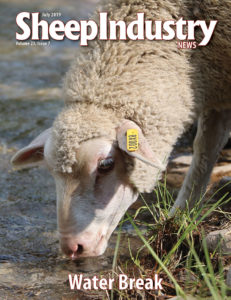ASI Heads to Pennsylvania for NLFA Leadership School
Benny Cox, ASI President
Summer is upon us and we are busy in our travels as representative for the sheep industry. This month, the ASI Executive Board, officers and staff will join the National Lamb Feeders Association in Pennsylvania in conjunction with the Howard Wyman Sheep Industry Leadership School.
It is in July every year that the executive board has a face-to-face meeting, and this year the NLFA school provided an opportunity to broaden our understanding of the ethnic market even further. We will have the opportunity to visit the auction in New Holland, Penn., on a sheep and goat sale day. That’s right down my alley.
Each and every year we spend at least a full day in our business meeting and a day or so visiting places that might be of interest to our group. I feel that the collective group can make better decisions when their knowledge covers all areas of the United States and the American sheep industry. The marketing of sheep and goats in the East and Northeast verses the far West and Northwest is very different. I for one have an understanding of the situations surrounding both the traditional and the non-traditional markets, but still think there could be more to learn just being in the thick of things, so I am looking forward to the trip.
In our monthly officer conference calls – as well as daily communications – there is always something to do. Last month, I spoke of our request for available funds approved in the Farm Bill. This month, we delivered our message making clear our wool export issues as well as the sheepskin problems stemming from tariffs imposed by China – which is where the majority of our wool and hides go.
Before the tariff issues, more than 70% of American wool has gone to China and 80 percent of the sheepskins. There will be many that benefit from the $16.1 billion agricultural relief plan the Trump Administration has implemented for those that are hurt by those imposed tariffs. Direct payments are scheduled to start in July and go through fall as I understand, while new alternative options for marketing are being searched out. We have seen two markets open for lamb exports in the last two years due to the efforts of ASI in Washington, D.C., so who knows what might happen in the days to come.
ASI is continuing to monitor the situation with China while fighting for funding on two fronts: to promote American wool in new and expanding export markets and to provide for direct payments to wool producers affected by the trade war with China. You can read more about those efforts on page 10 of this issue.
This year’s corn crop is in jeopardy thanks to widespread flooding in areas that raise the corn. Some areas that have been planted are under water and some producers are waiting to get into the fields. There is concern that it might be so late that some producers will be inhibited from planting corn at all this season. In the first week of June, there was a $19.1 billion disaster payout passed to help farmers affected by floods, as well as wildfires in other areas. One of the down sides in all of this is that the cost of corn will increase feed costs for many producers.



